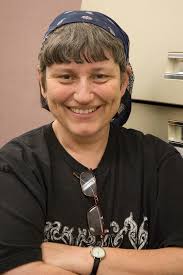With Rafailovich, scientific discoveries of small (and gigantic) proportions

Few researchers are as small-minded as Miriam Rafailovich.
And thank goodness for that. As director of Stony Brook University’s Thermonuclear & Imaging Nanoscale Characterization Laboratory (ThINC), Dr. Rafailovich manages a world-class array of microscopy technology – electron microscopes, cryo-scanners and more – offering unique perspectives on a wide range scientific challenges.
And as a core facility of the Advanced Energy Research and Technology Center (AERTC), ThINC sees plenty of those – making the lab’s transmission electron microscope (which zaps accelerated electrons through ultra-thin specimens), confocal microscope (ideal for three-dimensional fluorescent microscopy) and other next-level equipment a go-to resource for startups of every stripe.
That’s one of the things that most excites Dr. Rafailovich, who earned her PhD in nuclear physics from SBU in 1980: that ever-changing smorgasbord of disciplines and dilemmas filtering through the AERTC.
“The ThINC facility is exciting because it has all kinds of cutting-edge tools, and because we’re constantly learning how to apply them to different problems,” notes the distinguished professor of Materials Science and Chemical Engineering, who’s helmed the microscopy laboratory since it opened in 2014.
“It brings together academic expertise with industrial interests, and that’s always very good,” she adds. “Industry is very much in tune to what people want and need, and we can apply our talent and expertise to impactful discovery.”
Of course, Dr. Rafailovich is in hot pursuit of her own impactful discoveries. Right now, she’s knee-deep in polymers, which she describes as an “enabling technology” for solar energy, additive manufacturing and a host of front-line disciplines – including several with promising crossover potential.
“We are developing polymers for photovoltaic applications,” she notes. “And polymers for nanocomposites that operate under extreme conditions – for example, in fire retardants.
“Also, nanocomposites for 3D printing applications that produce high-quality reproduceable devices,” Dr. Rafailovich adds. “People are already trying to print photovoltaic cells.”
ThINC isn’t the only tank on Long Island with impressive microscopy equipment – similar tools are available at the Department of Energy’s Brookhaven National Laboratory. But the government facility has a slightly different focus, according to Dr. Rafailovich, who suggests a more intuitive route to scientific discovery at SBU’s nanoscale lab. The BNL facility is perfect for larger projects that could be generated after the efforts within the SBU facility are completed.
“At Brookhaven, you have to write a proposal and you have to go through the federal application process, and you have to know exactly what you want to do,” she says. “But sometimes, industry has a problem and they’re just looking for solutions – they really don’t know what they want, because they just identified the problem.
“So, they work with us, and ThINC comes up with original solutions.”
With AERTC clients plugging away and scientific inquiries popping up across the Stony Brook campus and beyond, the microscopy lab figures to keep busy. The next decade or so looks “very exciting,” according to Dr. Rafailovich, as engineering-driven medicine – an emerging discipline with obvious microscopic implications – flows into the mainstream.
“There’s a lot of energy generation going on at the tissue and molecular levels,” the distinguished professor notes. “For example, neuro impulses are transmissions of energy.
“One project uses photovoltaic polymers as a scalpel on the retina, using electricity to stimulate nerves,” she adds. “We are also seeing nanoscale characterizations of new energy materials and new biological materials.”
And as queries pour in from SBU’s School of Dental Medicine, Renaissance School of Medicine, College of Engineering and Applied Sciences and elsewhere, ThINC’s founding director will be standing by – thinking small, as always, and ready for a closeup.
“We work with so many different interesting sources,” Dr. Rafailovich says. “It’s always exciting to see what comes next.”
